Essay Contest Result
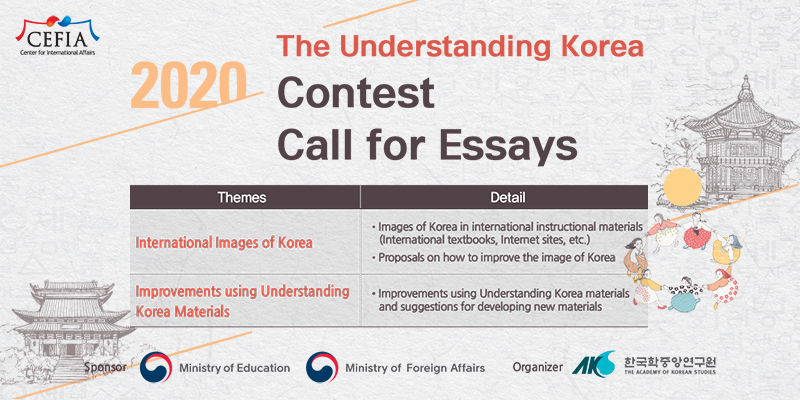
The Untapped Potential of Korean Art History
Introduction
Like many other fields, art history is gradually adopting a more global outlook. The primacy of Western art is no longer taken for granted and scholars are directing their focus towards non-Western art. Despite this trend, Korean art history remains relatively unknown and underappreciated in the West. While there is a plethora of English resources about Chinese and Japanese art, there continues to be a dearth of English-language materials on Korean art, especially introductory textbooks. An American student would not be exposed to the richness and diversity of Korea's visual culture through the limited English resources currently available. This is regrettable because the Korean peninsula served as an integral setting for the transmission of artistic trends throughout East Asia, and Korean art possesses a distinctness that sets it apart from the arts of its neighboring countries.Issues Concerning Instruction of Korean Art in American Art History Textbooks
An average American student might first encounter Korean art history through one of two types of introductory art history course: AP Art History or Art History 101. AP Art History is offered in high schools and Art History 101 is a general name for the art history survey course at many American universities. Both courses aim to provide a general introduction to world art and therefore often use the same textbooks. Two of the most popular textbooks are Marilyn Stokstad's Art History and Helen Gardener's Art Through the Ages. As Gardner's book contains more content relevant to non-western art, this essay will focus on the problems present solely in Gardener's book.First published in 1926, Art Through the Ages has greatly expanded its chapters about non-Western art through almost a century of continuous revision. The most recent edition is the most inclusive yet. However, its section about Korean art history still has room for improvement.
| A Dissection of the East Asian Art Chapters of Gardener's Art History Through Ages: A Global History (16th edition) | |||
| Country | Chapter Title | Pages | # of Images |
| China | Chapter 16: China and Korea to 1279 | 470-496 (26 pages) | 38 |
| Chapter 34: China and Korea, 1279-1980 | 1058-1071 (14 pages) | 28 | |
| Korea | Chapter 16: China and Korea to 1279 | 496-498 (3 pages) | 4 |
| Chapter 34: China and Korea, 1279-1980 | 1071-1072 (2 pages) | 2 | |
| Japan | Chapter 17: Japan Before 1333 | 500-516 (17 pages) | 27 |
| Chapter 35: Japan, 1333 to 1980 | 1074-1090 (17 pages) | 26 | |
One of the most apparent issues with Gardener's sections about Korean art is simply the lack of content. The number of pages dedicated to Korean art is pitifully low when compared to those devoted to China and Japan (Table 1). As a result of this drastic abbreviation, there are puzzling gaps in chronology and content. For example, both the Chinese and Japanese art sections begin in the prehistoric era, while the Korean art section begins with the Three Kingdoms period (Fig. 1), inadvertently suggesting that Korean art developed much later than its East Asian counterparts. In contrast, Korean art history textbooks published in Korea devote a considerable amount of text to the prehistoric era, especially to the creation and proliferation of comb-pattern pottery (Fig. 2) and bronze objects (Fig. 3). Another puzzling exclusion in Gardner's book is the absence of Goguryeo art in the Three Kingdoms section. Even the most basic Korean art history textbooks in Korea include the ornate tomb murals of Goguryeo which are critical to understanding the origins of painting on the Korean peninsula (Fig. 4).
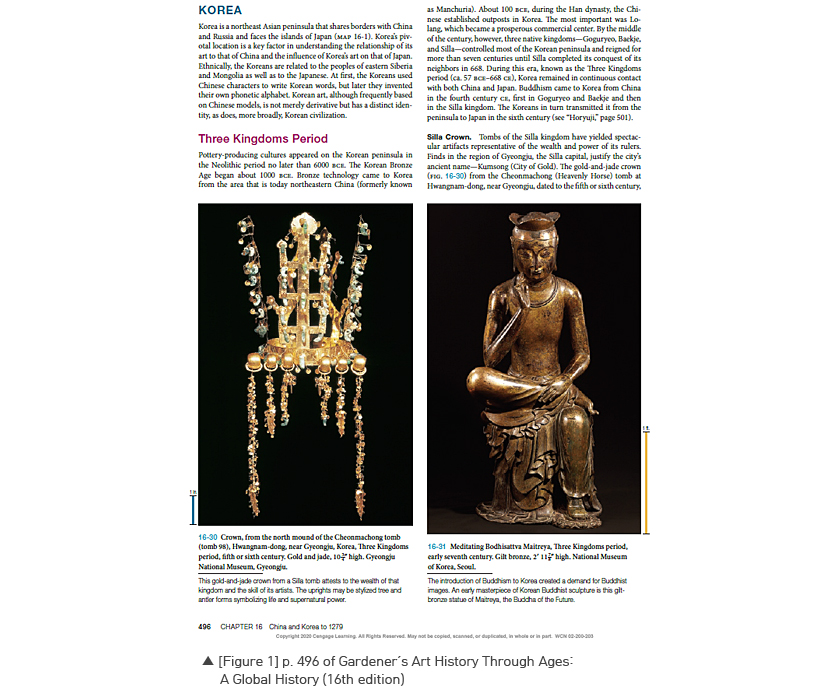
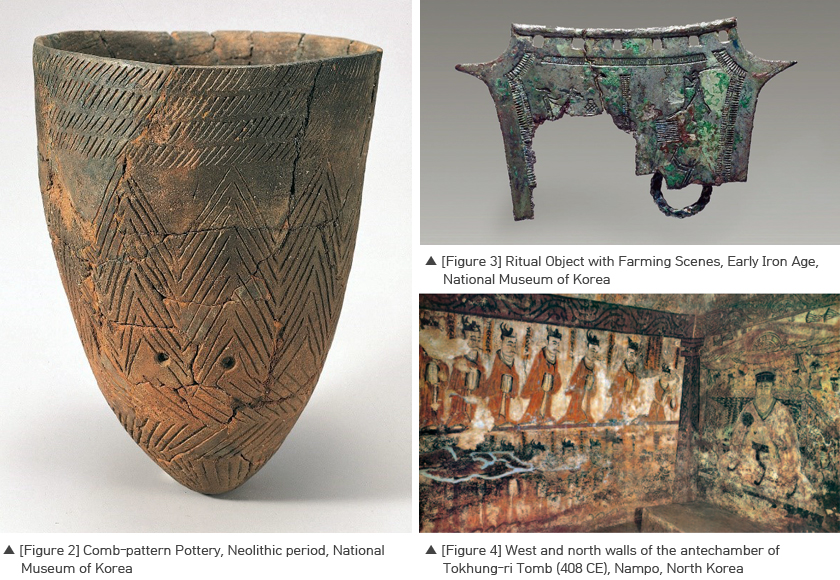
In addition, Gardner's book asserts that Korean art possesses characteristics that make it distinct from Chinese or Japanese art and but provides few pictorial examples to illustrate this. Among the hundreds of images in the textbook, there are only six included in the sections about Korean art. Some of the selections are also questionable. For example, a gold Silla crown and a bronze Meditating Bodhisattva Maitreya were chosen to represent the arts of the Three Kingdoms period (Fig. 1). While these two are undoubtedly masterpieces, the textbook omits critical works such as the Baekje Gilt-bronze Incense Burner (Fig. 5) and the Rock-carved Buddha Triad in Yonghyeon-ri, Seosan (Fig. 6). These two are iconic national treasures of the Three Kingdoms period but since they are not included in textbooks, few American art history students would know of them.
Another glaring omission is the absence of Korean pagodas. While brick pagodas proliferated in China and Japan primarily built wooden pagodas, Korean pagodas were mainly constructed from slabs of heavy granite and therefore unique in their construction and design (Fig. 7). Various examples of Korean stone pagodas remain scattered throughout the peninsula and they often played integral roles in the layout of early Korean Buddhist temple. If Gardner's book contained a comparison of Chinese, Korean, and Japanese pagodas, it would offer a more complete understanding of the transmission of Buddhist architecture throughout East Asia.
Another glaring omission is the absence of Korean pagodas. While brick pagodas proliferated in China and Japan primarily built wooden pagodas, Korean pagodas were mainly constructed from slabs of heavy granite and therefore unique in their construction and design (Fig. 7). Various examples of Korean stone pagodas remain scattered throughout the peninsula and they often played integral roles in the layout of early Korean Buddhist temple. If Gardner's book contained a comparison of Chinese, Korean, and Japanese pagodas, it would offer a more complete understanding of the transmission of Buddhist architecture throughout East Asia.
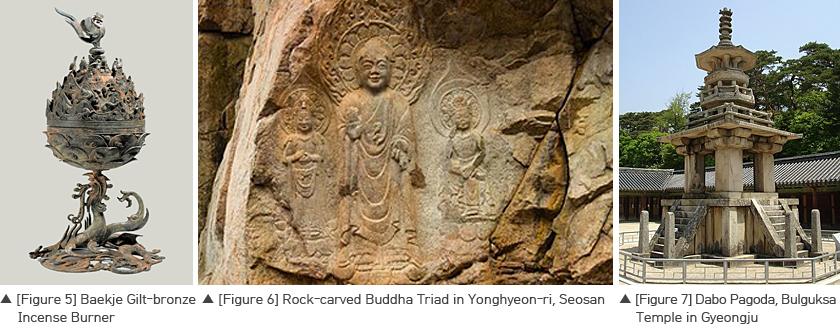
Lastly, what is probably the most problematic aspect of Gardner's textbook is the choice to lump Korean art and Chinese art together. Chinese art has indeed had a deep impact on Korean art, but Japanese art, which was also heavily influenced by China, is allotted its own chapter. By placing a few meager examples of Korean art at the end of a chapter dominated by Chinese art, Korean art suffers from the unfortunate impression that is it merely derivative of Chinese art and cannot stand on its own merit.
While the contributors Gardner's textbook should be lauded for their attempt to include more global perspectives, the current state of the Korean art sections leaves much to be desired. Not only is the information insufficient, when compared with the more detailed and thorough sections for China and Japan, one might arrive at the negative assumption that Korean art is less worthy of examination.
While the contributors Gardner's textbook should be lauded for their attempt to include more global perspectives, the current state of the Korean art sections leaves much to be desired. Not only is the information insufficient, when compared with the more detailed and thorough sections for China and Japan, one might arrive at the negative assumption that Korean art is less worthy of examination.
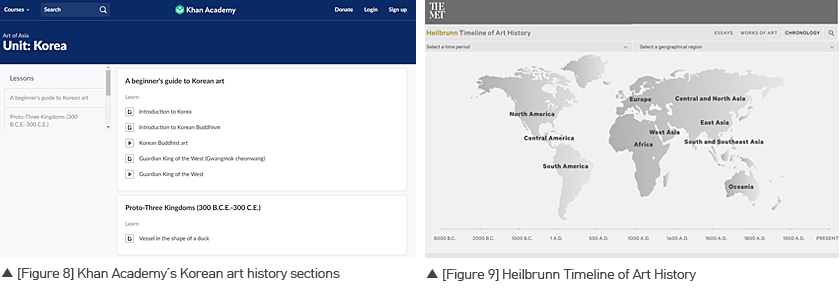
Proposals to Improve English Korean Art History-related Materials
There is an urgent need for resources that can provide a deeper and more thorough understanding of Korean art in the west. However, rather than improving upon the aforementioned textbooks, a far more cost-effective and efficient measure would be to concentrate on revising and disseminating digital content about Korean art. More and more American art history students are growing disenchanted with costly and heavy art history tomes, instead having an increasing preference for digital content. Korean cultural and educational institutions can capitalize on this trend to present a more accurate and fuller story of Korean art.One of the most popular online resources for American art history students is Khan Academy, a website that aims to provide free educational content presented by experts. For American students taking introductory art history courses, Khan Academy's art history lectures and essays are considered invaluable resources for understanding art objects in-depth. Currently, Khan Academy's Korean art section suffers from a lack of content (Fig. 8), however, through a partnership with Korea's Cultural Heritage Administration (CHA), this section could be tremendously expanded upon and improved. The CHA could license their vast image library for use and their network of scholars could be consulted to revamp the content about Korean art. Another benefit of this collaboration would be an increased awareness of Korean art. As Khan Academy is available to the general public, even those not enrolled in an art history course would be able to learn about the basics of Korean art.
Another worthwhile endeavor would be the creation of an interactive timeline of Korean art. Currently, the most well-known digital art history timeline is the Metropolitan Museum of Art's Heilbrunn Timeline of Art History (Fig. 9). It provides a visual chronology of world art which is an extremely useful tool, especially for understanding countries with long histories. If the National Museum of Korea were to produce something similar, integrating it with Korean art objects in their own collection, this online timeline of Korean art history would serve not only as a research asset for scholars but also as a way for the museum to organize and showcase its greatest treasures.
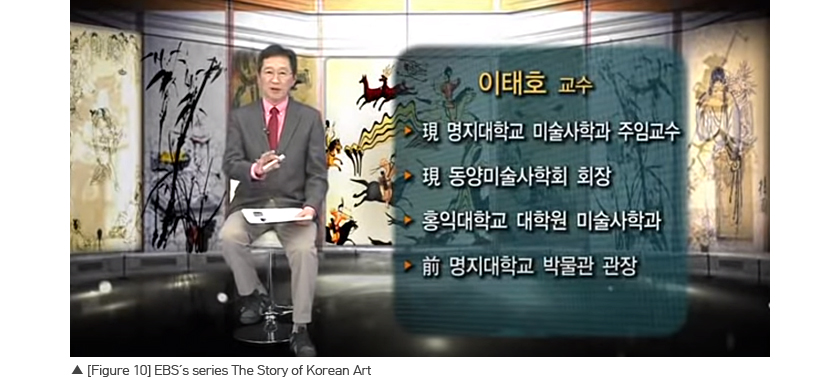
Lastly, English subtitles could be added to EBS's Korean art history series, The Story of Korean Art (Fig. 10). Currently available on YouTube, this series is presented by Professor Lee Tae-Ho, a renown scholar of Korean art history, and spans from the prehistoric era to modern times. English subtitles would be useful not only because it would teach Western students a broader view of Korean art, but the knowledge gained would be legitimized by the academic authority of its presenter.
The relatively underdeveloped pedagogy of Korean art in the West is not due to a lack of interest but rather to a lack of accessibility to accurate and comprehensive resources. Improving the English-language materials about Korean art would be the first step in increasing appreciation of Korean art in the West so that Korean art can finally be widely and rightfully recognized for its own merits.
The relatively underdeveloped pedagogy of Korean art in the West is not due to a lack of interest but rather to a lack of accessibility to accurate and comprehensive resources. Improving the English-language materials about Korean art would be the first step in increasing appreciation of Korean art in the West so that Korean art can finally be widely and rightfully recognized for its own merits.

